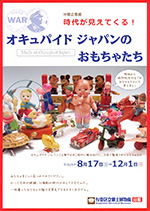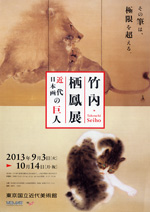 |
Picks is a monthly sampling of Japan's art scene, offering commentary by a variety of reviewers about exhibitions at museums and galleries in recent weeks, with an emphasis on contemporary art by young artists. |
 |
 |
 |
2 December 2013 |
 |
| 1 | 2 | |
 |
|
 |
 |
|
|
 |
 |
 |
 |
| Ueda Shoji 100th Anniversary |
| 12 October - 5 January 2014 |
Tokyo Station Gallery
(Tokyo) |
 |
| A photographer who proudly declared himself an "amateur" and did most of his work in his home district of San'in, on the Sea of Japan, Shoji Ueda (1913-2000) is best known for his idiosyncratically staged shots of subjects (usually family members) posing amid the sand dunes of Tottori. Coming at a time when Ueda, already a beloved icon at home, is finally gaining international recognition, this retrospective celebrates the centenary of his birth. |
|
 |
|

|
 |
 |
|
|
|
|
|
 |
|
|
|
|
 |
 |
|
| Toys of "Occupied Japan" |
| 17 August - 1 December 2013 |
Suginami Historical Museum
(Tokyo) |
 |
| "Made in Occupied Japan" was the label affixed to the vast quantities of toys exported by Japan -- almost exclusively to the U.S. -- during the postwar years of the American occupation. Culled from the extensive collection of illustrator Fumitaka Takayama, this exhibition also features toys from as far back as the Meiji era and into the late 1950s and early 1960s. One of its most intriguing aspects is the frequency with which very Japanese-y characters appear among products manufactured ostensibly for consumption by American kids. |
|
 |
 |
 |
|
| Takeuchi Seiho |
| 3 September - 14 October 2013 |
The National Museum of Modern Art, Tokyo
(Tokyo) |
 |
| Per the art-world cliche "Taikan in the east, Seiho in the west," seminal Nihonga painter Seiho Takeuchi (1864-1942), who was based in Kyoto, is habitually paired in alleged rivalry with his Tokyo contemporary, Taikan Yokoyama (1868-1958). But as this show demonstrates, Seiho was clearly the superior artist. Truth to tell, Seiho was a bit of a showoff, and his emphasis on technique for its own sake can get a tad tiresome. Though he depicted lions, skeletons, women, and Mt. Fuji with equal elan, one of his most astonishing works -- a masterpiece by any estimation -- is Roma no Zu (Historic Spot of Rome), a landscape of ancient European ruins rendered in traditional sumi ink on a multipanel byobu screen. |
|
|
|
|
 |
|
|
 |
|